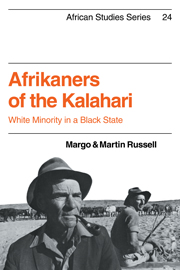Book contents
- Frontmatter
- Contents
- List of illustrations
- Acknowledgements
- A note on terminology
- 1 Southern Africa
- 1 The mundane Kalahari: an introduction
- 2 Boers, trekboers and bywoners: 1898–1930
- 3 Into the cash economy: 1930–72
- 4 Ghanzi Afrikaners 1973: a domestic description
- 5 Preserving boundaries: similarities, ambiguities and avoidances
- 6 Boers and Bushmen: dependence, interdependence and Independence
- 7 Sharing religion: attitudes to the conversion of the Bushmen to Christianity
- 8 Boers, bureaucrats and blacks
- 9 Prospect: whites in a black state
- Notes
- Bibliography
- Index
2 - Boers, trekboers and bywoners: 1898–1930
Published online by Cambridge University Press: 04 August 2010
- Frontmatter
- Contents
- List of illustrations
- Acknowledgements
- A note on terminology
- 1 Southern Africa
- 1 The mundane Kalahari: an introduction
- 2 Boers, trekboers and bywoners: 1898–1930
- 3 Into the cash economy: 1930–72
- 4 Ghanzi Afrikaners 1973: a domestic description
- 5 Preserving boundaries: similarities, ambiguities and avoidances
- 6 Boers and Bushmen: dependence, interdependence and Independence
- 7 Sharing religion: attitudes to the conversion of the Bushmen to Christianity
- 8 Boers, bureaucrats and blacks
- 9 Prospect: whites in a black state
- Notes
- Bibliography
- Index
Summary
The early history of the Ghanzi region of the Kalahari is not clearly known, but it seems that until comparatively recently it was the almost exclusive territory of hunting and gathering Bushmen as it had been for 20000 years. The steady southward movement of the Bantu had taken place beyond the periphery of the desert and it was not until the nineteenth century that population expansion, political change and the immense movements of peoples then taking place in southern Africa began to bring significant and increasing change into the Kalahari itself.
The Kwebe–Gobabis limestone ridge rises slightly out of the endless sandveld of the Kalahari, a great shallow depression across the centre of southern Africa. Here alone on the ridge the spasmodic desert rains are cupped in rock and replenished by springs in the limestone. A good rainfall can maintain springs here for as long as seven years. There are seasons in the sandveld after rain when the pans fill with water and the Kalahari vegetation burgeons with a vivid greenness, but such seasons are rare and brief and water quickly evaporates. In the past the more reliable water supply at Ghanzi brought immense quantities of game there, both large and small. Passarge in 1907 considered that it was at Ghanzi alone that a reliable food supply had enabled Bushmen to establish a more elaborate economic and political structure than elsewhere (1907:114–24).
- Type
- Chapter
- Information
- Afrikaners of the KalahariWhite Minority in a Black State, pp. 10 - 26Publisher: Cambridge University PressPrint publication year: 1979



